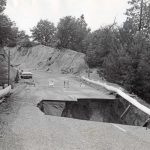Water sales revenue growing as expected
At their May 18 meeting, directors of the Fern Valley Water District reviewed the proposed budget for fiscal year 2018-19, which begins July 1, and took other financial actions.
Revenues are expected to grow 23 percent from the initial 2017-18 estimates. The contributor is water sales revenue, which is projected to be $650,000 compared to the original estimate of $500,000. This 30-percent growth is the result of the board’s rate increase in December. Next year, the preliminary estimate is $780,000.
Expenses are planned to increase from $1.3 million to $1.7 million, or 32 percent. Operating costs are growing almost $250,000 from the initial approved budget, but only $35,000 from the final projections for expenses.
The increase this year is the result of the board’s decision last month to pay off the unfunded liability for retiree health benefits. According to its actuary’s analysis, the district owed about $504,000 to bring the unfunded level to zero. The board agreed to pay half at the end of this fiscal year and the balance at the end of the next fiscal year.
Smaller increases for general engineering costs and staff salaries are included in the operational costs.
A year ago, the board approved a capital investment program of about $450,000. Hydrant replacement was budgeted for almost $200,000; however, this project has been delayed.
By the end of fiscal year 2017-18, June 30, capital expenditures will be about $155,000. For next year, the district is planning on a $625,000 capital program, which will include another $130,000 for the customer meter replacement project, $155,000 for the hydrant project and about $145,000 for a new backhoe. Materials and work at the filter plant are expected to cost about $60,000.
Approval of the final budget is scheduled for the June 15 meeting.
Other financial decisions included the approval of a salary step schedule for the district and the emergency replacement of the booster pump for Well no. 11.
Restoring this well to production is a priority, according to General Manager Victor Jimenez. As the stream flow decreases, FVWD’s dependence on wells grows. For example, wells were the source of nearly 35 percent of April’s production compared to 9 percent in 2017, which was a much wetter year.
“Well no. 11 is a very efficient well. Its gallons-per-kilowatt are very low,” Jimenez told the board. “This is our best producer now, and I want to get it back into service.”
With respect to water conditions, Jimenez reported, “The wells are all doing well. There have been moderate decreases in well levels.” But the groundwater level of three wells actually increased a few inches.
Consumption during the March and April billing period was 4.5 million gallons, about 75,000 gallons (or 1.7 percent) greater than in 2017. Total consumption in 2018 has been 9.4 million gallons, about 60,000 gallons less than the same period in 2017.
The unaccounted-for water estimate was 25 percent; however Jimenez stressed, “This is wrong. We have found no significant leaks that would account for this level. The older meters are reading bad and when the replacement project is finished, we’ll have a significant improvement.”
The Memorandum of Understanding with the local Mountain Disaster Preparedness group to establish a disaster assistance station on the district’s land near Upper Rim Rock was signed recently.










